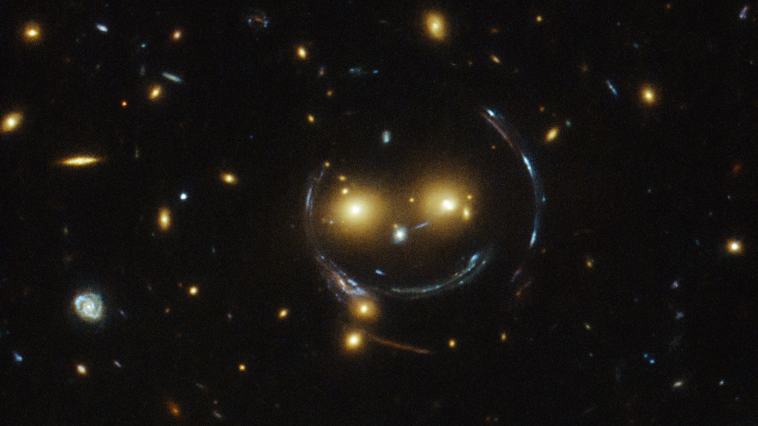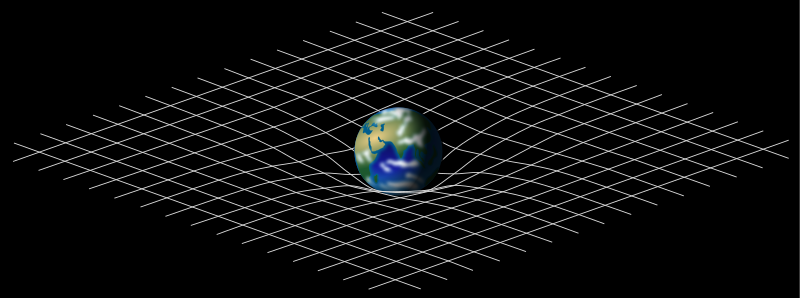Theory of Relativity

bent by the curvature of space caused
by the foreground galaxy cluster
Credit: NASA/ESA
Gravity is the force we are most familiar with in everyday life. It has been studied for longer than the other forces of nature. However, it is also the least well understood.
In 1915, Albert Einstein published his work on General Relativity. This was a new way to describe gravity. It built on the work of Sir Isaac Newton centuries earlier. Today, Einstein's theory is still the best explanation of gravity.
Newton had correctly explained that every object in the Universe has a force which can be felt by every other object as a ‘pull’. We call it an ‘attractive’ force because it attracts objects towards each other.
The strength of this force is linked to the mass of the object. The more massive the object, the stronger the force. Newton also found that the force is linked to the distance between the objects. The further the distance, the weaker the force.
Newton’s work on gravity is known as the Law of Universal Gravitation. It worked most of the time, but became less useful as we learned more about our Universe. Newton’s laws were not as accurate when dealing with very strong gravitational fields. Like those produced by massive objects in the Universe like stars, and black holes.
Einstein described gravity in a new way. He said that objects in space are so massive, they actually cause space (and time) to curve around them. How much they curve space-time is linked to the mass of the object, and its energy. This is know as the theory of General Relativity.
Scientists were able to predict how they could find evidence for Einstein’s ideas. They predicted that, if there was a star or galaxy hidden behind a massive object, the light from the star or galaxy would be bent around the massive object. Arthur Eddington proved this prediction correct in 1919. He was able to observe stars behind the Sun during a solar eclipse. The light from those stars followed the curve in space-time caused by the Sun's mass.

Credit: Mysid
The theory also predicted that a strange object could exist. This massive object would curve space-time until it closed up on itself. We now know these objects to be black holes.
It wasn’t until the 1990s, that we had the first strong proof that black holes were real. Astronomers were tracking stars near the centre of the Milky Way,. They noticed that the stars were in orbit around an object which could not be seen. They used the speeds and orbits of the stars to work out the mass of the black hole. It turned out to be over 4 million times the mass of our Sun!
The theory also predicted the existence of gravitational waves. These were detected for the first time in 2015.
Einstein also accurately described the motion of objects. This is built on the knowledge that light travels at a fixed speed in a vacuum and the idea that space and time are linked. He showed that the speed of light is a limit that other objects cannot reach. The famous E=mc2 equation comes from this theory, where E is energy, m is mass and c is the speed of light.
A strange outcome of the theory is that time is relative to the people observing it. If someone moves very quickly, they experience time more slowly than someone observing them who is moving at a slower speed. The person moving quickly experiences a larger gravitational field. This causes time to slow down, but only for them. We call this time dilation. The effect is stronger the faster a person or object moves. These effects only become observable at very high speeds, so we don’t notice them in everyday life.
In 1971, an experiment was carried out to test the theory of relativity. Four atomic clocks were placed on planes while other clocks remained on the ground. The planes flew around the Earth several times. After the flights, the times on the clocks were compared. The ones on Earth showed different times to the ones which had been on board the planes. The differences agreed with the theory of relativity.
Relativity has implications for clocks on satellites. They run more quickly than those on the Earth's surface. This is because they are in a weaker gravitational field. Navigation systems like GPS only work if we take time dilation into account!

